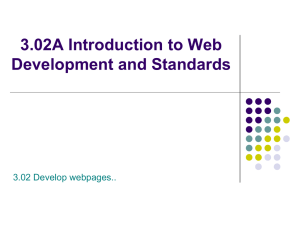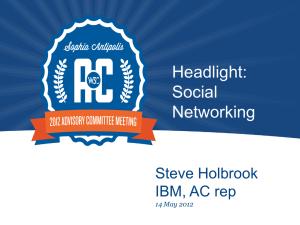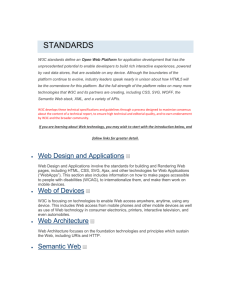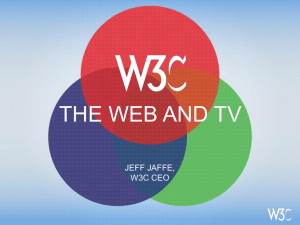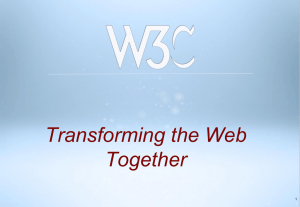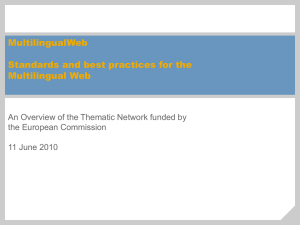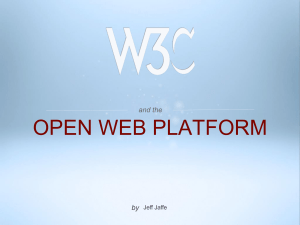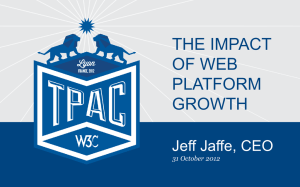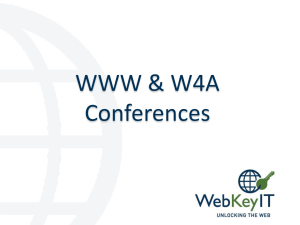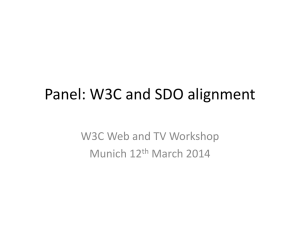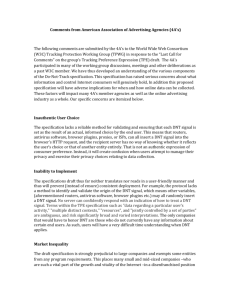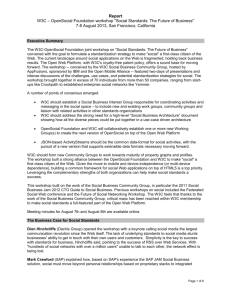Strategy_Brief_for_Coca-Cola_W3C_relationship_final
advertisement
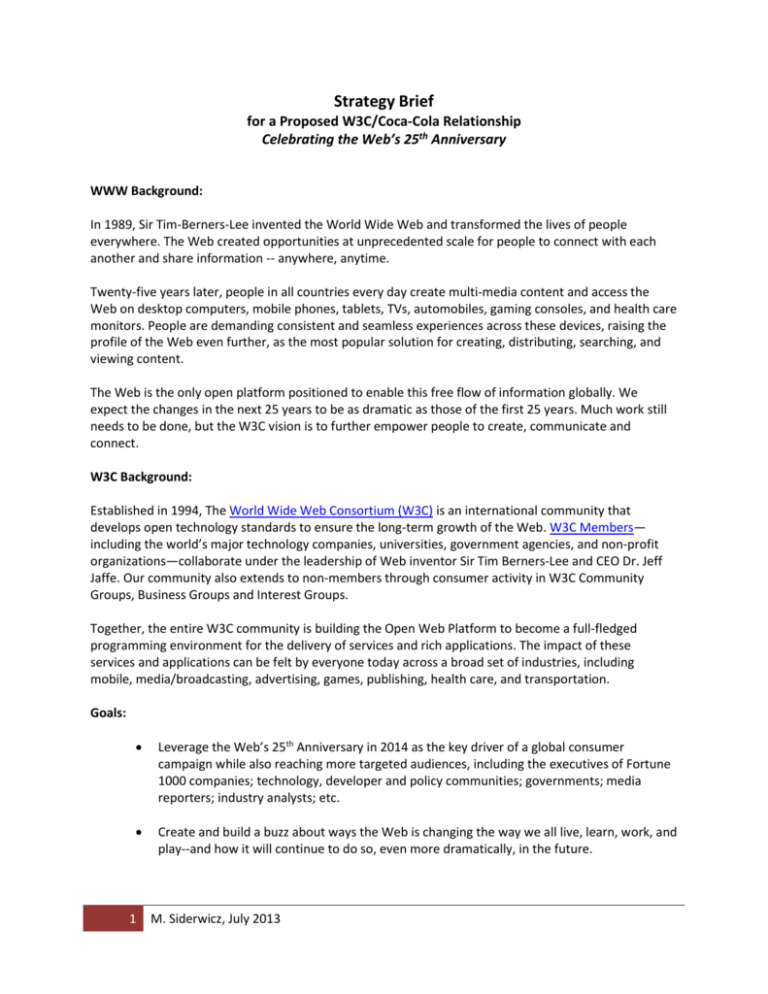
Strategy Brief for a Proposed W3C/Coca-Cola Relationship Celebrating the Web’s 25th Anniversary WWW Background: In 1989, Sir Tim-Berners-Lee invented the World Wide Web and transformed the lives of people everywhere. The Web created opportunities at unprecedented scale for people to connect with each another and share information -- anywhere, anytime. Twenty-five years later, people in all countries every day create multi-media content and access the Web on desktop computers, mobile phones, tablets, TVs, automobiles, gaming consoles, and health care monitors. People are demanding consistent and seamless experiences across these devices, raising the profile of the Web even further, as the most popular solution for creating, distributing, searching, and viewing content. The Web is the only open platform positioned to enable this free flow of information globally. We expect the changes in the next 25 years to be as dramatic as those of the first 25 years. Much work still needs to be done, but the W3C vision is to further empower people to create, communicate and connect. W3C Background: Established in 1994, The World Wide Web Consortium (W3C) is an international community that develops open technology standards to ensure the long-term growth of the Web. W3C Members— including the world’s major technology companies, universities, government agencies, and non-profit organizations—collaborate under the leadership of Web inventor Sir Tim Berners-Lee and CEO Dr. Jeff Jaffe. Our community also extends to non-members through consumer activity in W3C Community Groups, Business Groups and Interest Groups. Together, the entire W3C community is building the Open Web Platform to become a full-fledged programming environment for the delivery of services and rich applications. The impact of these services and applications can be felt by everyone today across a broad set of industries, including mobile, media/broadcasting, advertising, games, publishing, health care, and transportation. Goals: Leverage the Web’s 25th Anniversary in 2014 as the key driver of a global consumer campaign while also reaching more targeted audiences, including the executives of Fortune 1000 companies; technology, developer and policy communities; governments; media reporters; industry analysts; etc. Create and build a buzz about ways the Web is changing the way we all live, learn, work, and play--and how it will continue to do so, even more dramatically, in the future. 1 M. Siderwicz, July 2013 Objectives: Invite people everywhere to celebrate and participate in the Web's 25th anniversary (and by association, W3C's 20th anniversary in ’14) through personal story-telling about their experiences with the Web. Increase engagement, interaction and scale of the celebration through broad industry partnerships. By association, gain traction of a newly deployed, refreshed W3C brand promise to attract dynamic people and organizations to W3C to continue to build the Web of the future. Target Markets: Primary Audience: the largest possible audience including current and future Web users. More targeted audience: business, technology, policy, government, and non-profit professionals who help build and use the Web to create economic and social value. Shared Values Opportunity: 25 Years of Bringing People Together on the Web Let’s combine together some of the biggest brands (e.g. Coca-Cola, P&G, Nike, Ikea, and [W3C Member companies?]) with some of the world’s biggest platforms (e.g. Google, Intel, Tencent [China], an auto OEM?, etc.) with some of the biggest agencies (e.g. Leo Burnett, Ogilvy, etc.) and some of the world’s media companies (e.g. Comcast, BBC, Globo, etc.). By bringing these disparate groups together, we can create more buzz and impact than we could alone to celebrate the Web. We should include global industries/companies that all share similar brand ideals. Ideals Marketing Approach: Let’s build an ideals framework and communicate one or more of the following ideals as part of the Web’s 25th anniversary. These ideals were presented as a framework by Jim Stengel, in his 2012 book, Grow: How Ideals Power Growth and Profit at the World's Greatest Companies, but also represent the Web’s ideals. The first ideal--Eliciting joy, or happiness--already is associated with the Coca-Cola brand. Eliciting joy: Activating experiences of happiness, wonder, and limitless possibility Enabling connection: Enhancing the ability of people to connect with one another and the world in meaningful ways Inspiring exploration: Helping people explore new horizons and new experiences Evoking pride: Giving people increased confidence, strength, security and vitality Impacting society: Affecting society broadly, including by challenging the status quo and redefining categories 2 M. Siderwicz, July 2013 Create Liquid and Linked Value: • Develop a big idea that encapsulates, and exponentially grows, our organizations’ many smaller initiatives focused on building and communicating the power of the Web. Stress emotional engagement. Leverage viral potential to amplify messages. Use creativity to impact popular culture on a wide scale. W3C Creative Story Arc: 1. Pause and Reflect: Help people make sense of the transformational disruption happening all around them (e.g. changing landscape of communications, media, music, gaming, publishing, transportation, urban design, health care, advertising, etc.) 2. Educate and Inform: Help people recognize that human potential lies within the Web’s powers of global connectivity and inter-operability (and by association, connect W3C’s role as architect and builder). Let’s create positive change in global society by working together to drive innovation and solve the world’s biggest problems. 3. Advance Thought Leadership: our global ‘on-demand’ culture can be a force of good, activity, enlightenment, and empowerment. 4. Set Future Framing: Let’s start a conversation to share ideas and ideals about ways Web technology standards shape the Web and drive progress. NOT TO BE CONSIDERED AS PART OF THE SUBSEQUENT CAMPAIGN BRIEF, BUT MORE DIRECTLY PART OF W3C’S BRAND STRATEGY. Brand Vision and Architecture (BVA Statement): Q. How will W3C and other Web organizations succeed in making the world a better place? A. The World Wide Web Consortium (W3C) is the international forum leading the development of technology standards and the stewardship of the Open Web. The impact of our work can be seen in the innovation, transparency and empowerment enabled by the Web, all of which contribute to improved economic and social development worldwide. Shape the Web at W3C. 3 M. Siderwicz, July 2013
